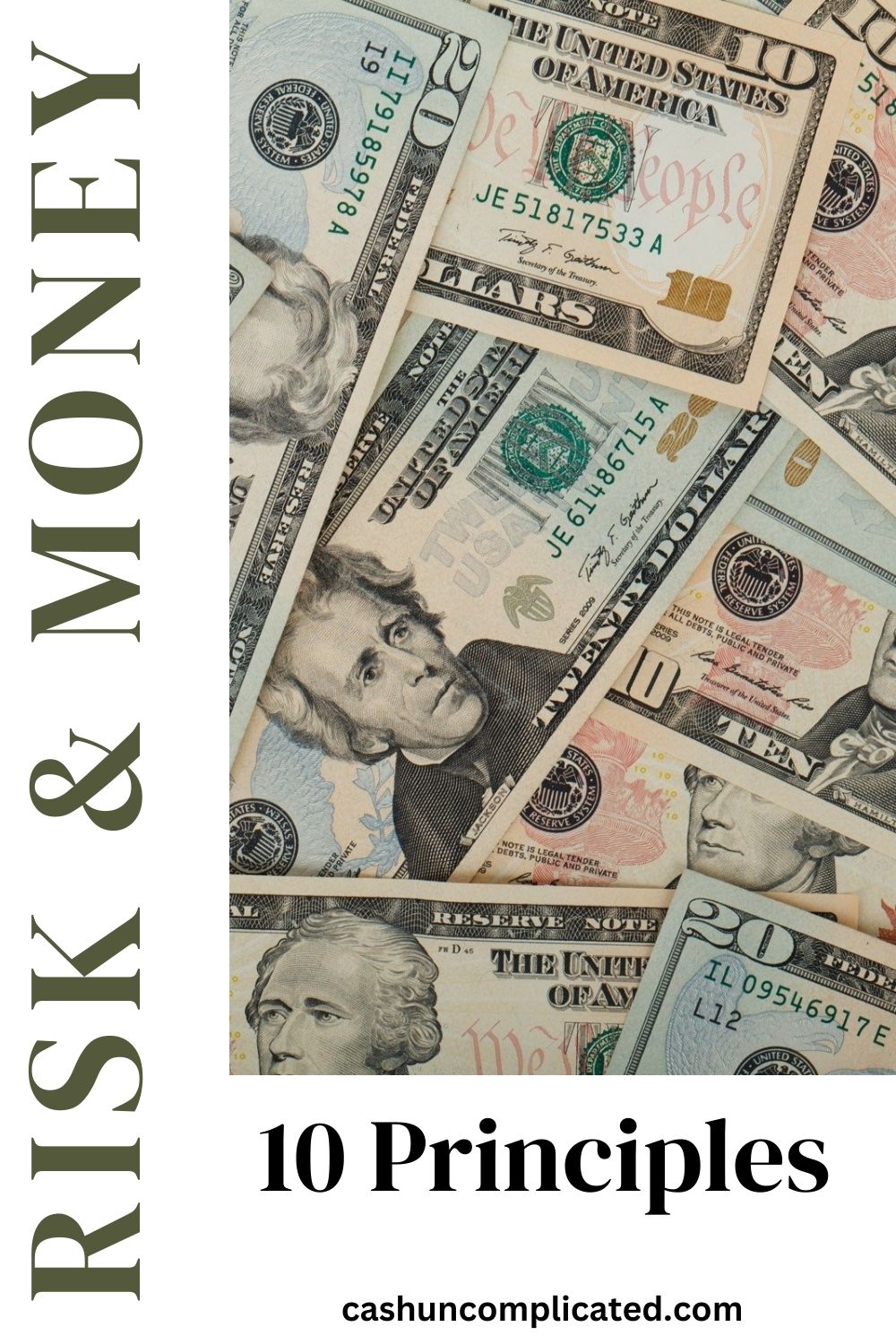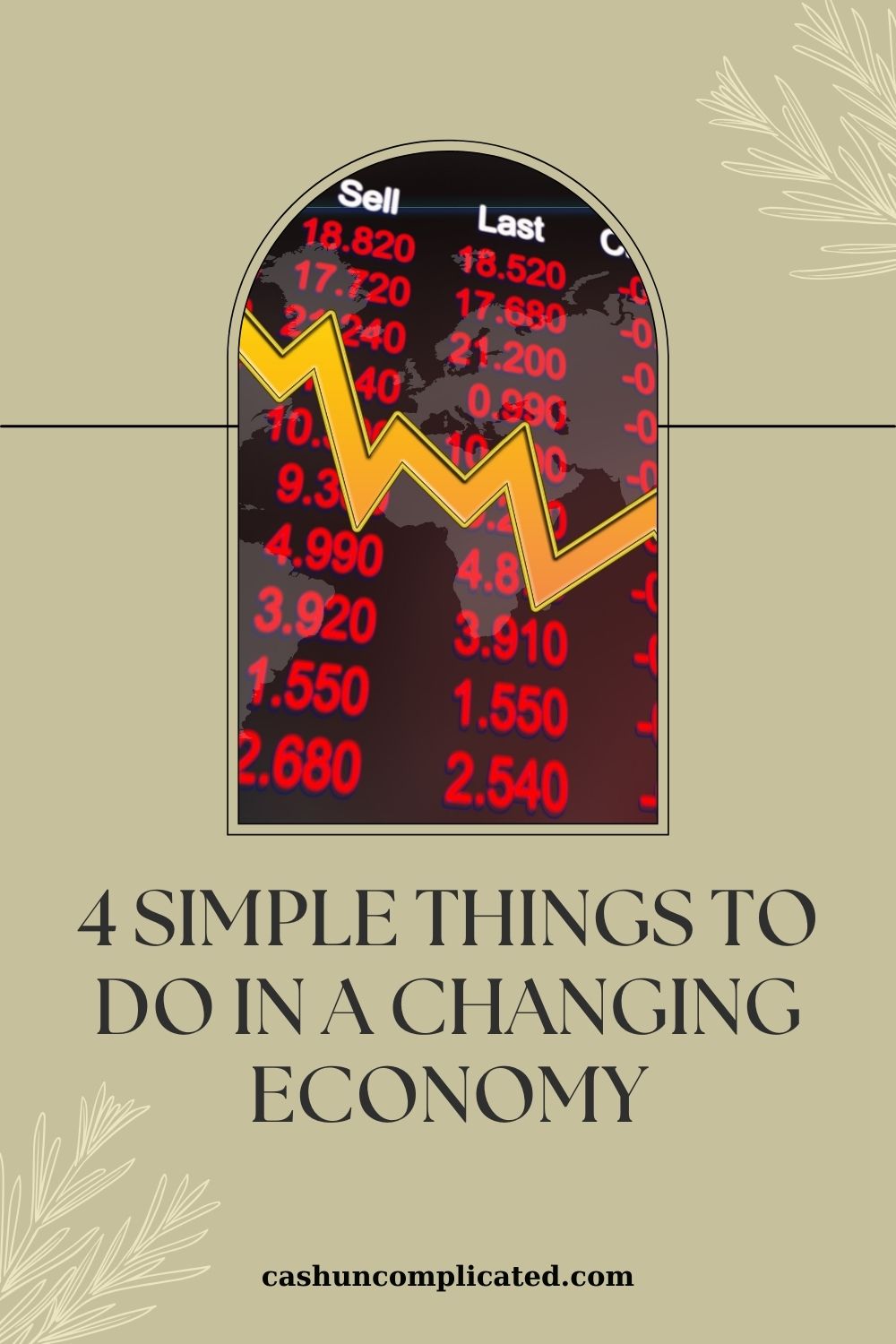Money doesn’t come without risk. An investor with a successful 10 year or more track record has risk, a conservative retiree with all their money in high-yield savings accounts and bonds has risk, as does the person who stuffs cash under their mattress. Risk and money can’t be avoided.
What Do I Mean by “Risk and Money?”
Here’s what I mean by risk and money, using the examples I gave above. The successful investor has market risk, sequence of returns risk, and much more. Although this investor in the example is successful, it’s impossible to have a great year every year.
There are going to be bad times in addition to the good. If the bad years are too bad, it can wipe out a high percentage of a portfolio.
The retiree with all of their money in a high-yield savings account and/or bonds risks losing their spending power due to inflation. Especially with some of the very high inflation we’ve seen over the past few years.
Even the person stuffing cash under their mattress faces risk (I’d actually say the most risk). They aren’t going to have the market volatility of the stock market but they will lose lots of spending power as inflation occurs. Not to mention the risk of the money being lost, stolen, burned in a fire, etc.
What Does Risk Have to Do With Money?
Everything I would argue. All money comes with risk, no matter how aggressive or conservative you are.
Risk can be minimized or mitigated, but it can’t be completely eliminated. The plan you choose to reduce risk will greatly determine your success with money.
Risk and Money Principles
These are ten risk and money principles I think are very important. Follow these principles and I believe that your risk will be greatly reduced.
Number 1: It’s Never Too Good to be True
This is true in life, not just in money. It’s never too good to be true. And if it is too good to be true, there’s probably something wrong. In many cases, very wrong.
In the average investor’s lifetime, they are going to be presented with numerous opportunities. Many of them good, some not so good, and others that are dangerous because they seem too good to be true.
The too good to be true investments are the ones that can sink us, and that we need to be very careful of. They look so good and shiny from the outside but inside is dynamite that can explode in our face.
Number 2: It’s Never as Good or Bad as it Seems
It’s never as good or bad as it seems. When assessing risk, this is a very important principle to remember. A great investor avoids the high highs and low lows.
When we get caught up emotionally in the high highs and low lows, we are much more likely to make bad decisions. During the high highs, the inclination is to buy, buy, buy.
During these times, it seems like all the market does is go up. As a result, these high highs lure us into the trap of using all our cash to invest, or over-leveraging. Both are dangerous when the good times stop.
It is also never as bad as it seems. When the market is plummeting, it seems like the only place for it to go is down, and then down some more. This is where many investors panic sell.
When in reality this is the worst time to sell because you are realizing actual losses. Then what many investors do is wait until the market goes back up to invest again. But by this time, the market is already up so gains are not realized as much as they should, or could, have been.
Number 3: There’s No Such Thing as Completely Eliminating Risk
It’s appealing to eliminate all risk. The truth though is there is no way to completely eliminate all risk. The best we can do is eliminate as much risk as possible.
Trying to eliminate all risk is an exercise in futility and it can’t be achieved. For example, someone trying to eliminate the risk of market volatility could hoard cash. But they are also at risk of losing a lot of money to inflation.
Likewise, someone wanting to reduce the risks of inflation who buys assets that have traditionally appreciated are at risk of market volatility.
In non-money examples, a cyclist is at risk of falling off the bike, getting hit by a car, pulling a muscle, etc. A sedentary individual who sits at home all day doesn’t face these same risks as the cyclist.
However, the sedentary individual is at much more risk of obesity, poor physical and mental health, loss of a social life, etc. Either way there is risk, and I’d argue much more risk with the sedentary life.
Related: Investing is Risky–Not Investing is Even Riskier
Number 4: History Doesn’t Repeat Itself, But It Often Rhymes
Mark Twain’s famous quote, “History doesn’t repeat itself, but it often rhymes” applies to money and risk (and many other things). The past doesn’t perfectly repeat, but there are lots of similarities.
More importantly, we can learn from the past.
All throughout history, people have acted with greed and fear. Panic selling, leverage, buying only during market surges, etc.
Understanding human behavior and the way people acted in the past and present can help us manage risk with money. For example, when the masses are saying to buy this one particular stock, I’ve got a pretty good idea that it’s already late in the game.
The best deals don’t go to people hearing about them on mainstream news outlets or from their friends in the neighborhood. Those deals have long since passed.
Same for when people are panic selling or saying the market will never recover. This is fear, and when the masses are fearful there is usually opportunity somewhere.
Book Recommendations:
Number 5: Lots of Risk in Good Times
In the good times, the market is high, real estate prices are near historic levels, and work is plentiful. It’s easy to get overzealous during the good times because there’s a tendency to think they will never end. The reality is they do, and then there’s increased risk.
For example, during the good times people may overextend themselves to buy a house they will have trouble affording. The prevailing thought is that they will “grow into the payment.”
One of the big risks not considered here is what happens if there’s a job loss or reduction in income. If you’re already over-extending yourself and then lose or have that income reduced, you’re in a really bad spot.
Versus someone who is more cautious and buys less house than they can afford who will be able to absorb a job loss or income reduction.
Number 6: Lots of Opportunity in Bad Times
Just like there is lots of risk in good times, there is a lot of opportunity in bad times. In the bad times, prices and confidence are lowered, and opportunities to buy assets are increased.
For example, when the stock market drops after a panic-selling event, the prices to buy stocks are less. In other words, they are on sale. After a market crash or correction is one of the best times to buy more stocks than you normally would.
One caveat is that it’s impossible to tell when the “bottom” has been reached. So when there is a market correction or crash, the wise investors take the opportunity to buy not necessarily knowing when the bottom will occur. The prices could fall lower, but the investor is still getting in at a very good price compared to pre-correction or crash.
Number 7: You Cannot Predict the Future
One of the biggest lessons I’ve ever learned about money and risk is that you cannot predict the future. No matter how smart you are, or how hard you try, it’s impossible to predict the future.
Someone might get big events in the future right now and then, but nobody is going to get them all. Another big thing few people talk about is those who predicted a big event correctly also had many false predictions, causing them to act a certain way and miss opportunities.
For example, someone who correctly predicted the 2008 financial crisis probably also predicted a similar crisis in other years leading up to the big event. That belief led them to behave in a certain way (not buy) and miss out on big gains. They also might miss market opportunities in the years after correctly predicting a crash, acting with extreme caution.
Here’s a table to illustrate the point, using 10 predictions.
| Prediction 1 | Incorrect, lost out on market opportunities |
| Prediction 2 | Incorrect, lost out on market opportunities |
| Prediction 3 | Incorrect, lost out on market opportunities |
| Prediction 4 | Incorrect, lost out on market opportunities |
| Prediction 5 | Incorrect, lost out on market opportunities |
| Prediction 6 | Incorrect, lost out on market opportunities |
| Prediction 7 | Correct, saved 35 percent of portfolio from crashing |
| Prediction 8 | Incorrect, lost out on market opportunities |
| Prediction 9 | Incorrect, lost out on market opportunities |
| Prediction 10 | Incorrect, lost out on market opportunities |
Out of 10 predictions, this investor got one right. Getting it right saved a huge amount of money by avoiding losses during a crash, but it came at an even bigger cost. This investor was also wrong nine out of 10 times, missing out on tremendous market gains.
So the nine wrong predictions was much more costly than the benefit of getting one right.
Number 8: Take a Little Something Off the Table
I’m all for people taking more risks when they’re younger. A job with more upside, higher risk investments, a real estate deal with a high upside, etc.
Once you acquire wealth though, you want to preserve what you’ve built. That often means taking a little something off the table. For example, someone invested 100% in index funds might want to reallocate a percentage to another less volatile investment.
Same for an angel investor who risks a large percentage of her money on startups. She might want to reallocate to different positions in order to preserve wealth.
There is wisdom in knowing when it’s time to grow and take risk versus when it’s time to take some risk off the table.
Number 9: Knowledge and Wisdom Prevail
When it comes to risk and money, there is one thing that will always prevail: knowledge and wisdom. Knowledge about investing, how money works, compound interest, virtues of avoiding consumer debt, etc.
Wisdom to know when you’re winning the money game and should start taking some risk off the table. Knowledge and wisdom will always beat shortsightedness, greed, and fear.
The next question is how to acquire knowledge and wisdom. I don’t think there’s any shortcuts to this. Time, consistency, and learning from experience are the main ways to acquire it. Learning doesn’t happen overnight and no matter how technology evolves, never will.
Number 10: The Masses or Pack is Usually Wrong
When you hear the pack talking about a particular investment, how hot the market is, or how the market is going nowhere but up–it’s time to be careful. I always go back to Warren Buffet’s quote: “Be fearful when others are greedy, and greedy when others are fearful.”
I think people are generally well intentioned, but human psychology gets the best of all of us. It’s natural to develop a pack mentality and start listening to what others are saying. Problem is by the time “everyone” is saying something, it’s probably too late.
For example, prior to the 2008 housing crisis, the masses were talking about things like speculation, unsafe leverage, and making a quick $100k by buying and selling a house in under six months. When the Average Joe starts talking about making six figures in under six months with real estate speculation, it’s time to assess risk and be very careful.
Conclusion
Money and risk go together. That’s why it’s so important to accurately assess risk and re-evaluate risk based on your current situation.
For example, a 25 year old without a spouse and family can take on a lot more risk than a 60 year old near retiree supporting a spouse and three kids. Wealth isn’t just about the building stage, it’s also preserving your capital and protecting what you have earned.
Take some time to assess your risk. Make it a habit to re-evaluate your risk at least once every couple years as your circumstances change.
How has your risk tolerance changed over the past few years?









